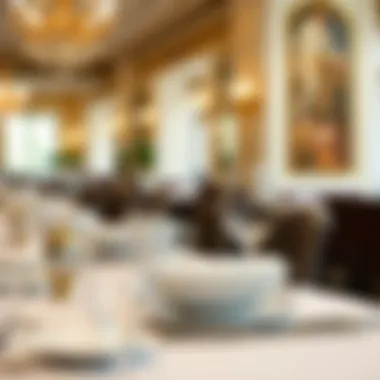Exploring Restaurant Place Settings for Enhanced Dining


Intro
Restaurant place settings play a pivotal role in shaping the dining experience. Beyond mere functionality, they create an atmosphere that welcomes, excites, and engages diners. Each detail, from the choice of cutlery to the arrangement of plates, contributes not just to a meal but to a memory. This narrative aims to explore the various dimensions of place settings, understanding their significance and the artistry involved in crafting them.
Place settings are not only about aesthetically pleasing arrangements but also about practical elements that enhance service efficiency. In this exploration, restaurant owners and interior designers alike will discover how to balance beauty with function. Key components such as tableware, linen, and the way they are organized will be examined, providing valuable insights into creating an inviting environment for any dining occasion.
Next, we will delve into Furniture Design Trends which are just as essential in establishing the right ambiance for place settings.
Understanding Restaurant Place Settings
In the realm of dining, whether in a chic bistro or a lavish restaurant, place settings play a pivotal role in crafting the dining experience. A place setting is more than just an arrangement of tableware; it’s a delicate dance of culture, aesthetics, and functionality that can elevate a meal from ordinary to extraordinary. The art of setting a table involves a deep understanding of the elements that contribute to both the visual presentation and the practical flow of a dining occasion.
Definition and Significance
A restaurant place setting typically encompasses everything from dishes and cutlery to glassware and linens. Defined simply, it is the arrangement of these items in a way that is both pleasing to the eye and conducive to a positive dining experience.
The significance of a well-thought-out place setting cannot be overstated. It sets the tone for the meal, often serving as the first impression for guests. A beautifully arranged table can spark conversations and enhance the overall ambiance of the dining venue. Furthermore, it communicates the level of formality expected during the meal, signaling to patrons the style of service they can anticipate. This, in turn, can greatly influence a diner’s overall satisfaction with their experience, reaffirming the notion that sometimes, the presentation is a part of the meal itself.
Cultural Influences on Place Settings
Cultural norms play a significant role in how place settings are crafted across different dining experiences. Various cuisines around the world utilize different styles and components, reflecting their rich traditions and customs. For example, in Italian trattorias, you might find simple ceramic plates paired with rustic linen napkins, whereas Japanese dining establishments typically feature lacquered ware and minimalist designs to evoke a sense of tranquility.
When considering cultural influences, one must also think about table manners, etiquette, and the significance of each item included in the setting. The placement of chopsticks, forks, or spoons can vary widely – and understanding these nuances helps in curating an authentic dining experience.
Moreover, contemporary trends have seen many restaurants blend traditional and modern elements, creating unique hybrid place settings that cater to multi-cultural influences. These setups not only accommodate diverse palates but also engage the diners in a narrative that spans different cultures and traditions, ultimately enriching their experience.
In essence, understanding restaurant place settings is a key aspect of elevating dining experiences. By grasping the myriad components and cultural significances, restaurant owners, interior designers, and even decorators can create a space that is both inviting and informative, ensuring that each meal served resonates deeply with every guest.
Key Components of a Place Setting
An effective place setting is foundational in creating a seamless dining experience. It's not just about aesthetics, but also about functionality and comfort. Each component plays its own role, whether it’s how the food is served or how guests interact with each other. Understanding these key components can greatly enhance the dining atmosphere, making it more memorable and enjoyable.
Tableware Essentials
Tableware forms the backbone of any place setting. It includes plates, bowls, and serving dishes, all crucial in defining the dining experience.
- Plates come in various sizes and types; a dinner plate is usually 10 to 12 inches in diameter, while a salad plate might be smaller, around 7 to 9 inches. Larger plates serve as canvases for beautifully plated dishes, while smaller plates help in portion control and variety in meals.
- Bowls are equally important for soups, salads, and sides. The depth and shape can accentuate the dish’s presentation. For instance, a shallow bowl can make a simple salad leap off the table visually.
- Serving dishes are used for communal dining, encouraging interaction. They should complement the tableware while also being practical.
When selecting tableware, consider not just the design but the durability as well, especially in busy restaurant environments.
Cutlery Arrangement
The way cutlery is arranged is more than just a matter of etiquette; it adds to the overall dining experience. Each piece of cutlery has its designated place, fostering familiarity and comfort for the diner.
- Outside-to-inside rule: This dictates that the cutlery required first should be placed furthest from the plate. For example, if a three-course meal is being served, the fork for the appetizer would go outside the knife for the entrée.
- Consistency in design: Pleasant visual harmony can be achieved by using cutlery that matches the tableware. This doesn't just speak to aesthetics; it can create a cohesive theme that enhances the dining experience.
An interesting trend is using a variety of materials for cutlery – from traditional stainless steel to sustainable bamboo or even innovative ceramic designs. Consider the overall theme and ambiance of the establishment when choosing materials.
Glassware Selection
The selection of glassware is not simply about function but extends deeply into the narrative of the meal. The type of glass influences not only the look but also the sensory experience of drinking.
- Wine glasses: Different types, like red and white, have unique shapes tailored to enhance specific flavors and aromas. A red wine glass is often broader to allow oxygenation, whereas a flute for sparkling wine is tall and narrow, preserving bubbles longer.
- Water glasses: They should be versatile yet elegant, keeping the theme consistent without overshadowing the wine or cocktails.
- Specialty glassware: Depending on the menu (think craft cocktails), having dedicated glasses can add sophistication to the place setting.
Choosing glassware that reflects the restaurant's branding can amplify customer experience, creating a cohesive identity.
Textiles and Linens
Textiles add warmth and a personal touch that is often overlooked. From tablecloths to napkins, these elements provide an opportunity to express the restaurant’s style.
- Tablecloths: High-quality fabrics can set the tone, whether it's an upscale dining establishment or a laid-back bistro. A crisp white linen offers elegance, while vibrant colors can evoke a more casual vibe.
- Napkins: Folded strategically, they can reflect sophistication; from simple rectangles to intricate designs, they play a significant role in table presentation.
- Placement: Napkins can be placed either on the plate or to its left, with the choice often depending on formality.
Thoughtfully chosen textiles not only contribute aesthetically but also functionally, providing comfort and cleanliness during the dining experience. Incorporating elements that resonate with the style of the dining environment will enhance the guest experience.
By understanding these components and their interactions, restaurant owners can create settings that not only look appealing but effectively support the overall dining experience.
Different Styles of Place Settings


Different styles of place settings play a pivotal role in establishing the atmosphere and character of a dining experience. Whether one is designing a quaint café or an upscale fine dining restaurant, the arrangement of tableware and the aesthetics of the setting contribute significantly to the overall guest experience. Various styles can dictate how a meal is perceived—from casual gatherings to formal banquets, each style communicates a different message and mood. Understanding these styles brings not only aesthetic benefits but practical considerations that enhance functionality for both diners and staff alike.
Formal Settings
In formal settings, the attention to detail is paramount. These arrangements are often characterized by a precise layout with multiple courses and intricately designed tableware. For instance, a classic formal setting might include multiple forks, a knife, a spoon, and various types of glassware, each serving a specific purpose corresponding to the meal course. The use of fine china and polished silverware typically elevates the dining experience.
When setting up a formal table, it is not just about appearance; it’s about etiquette. Learning the correct placement of each item according to standards adds a layer of sophistication. The correct sequence creates an aura of elegance that allows diners to enjoy multiple courses seamlessly.
Here are elements one typically finds in a formal place setting:
- Multiple utensils: knives, forks, and spoons, often for each course.
- A center piece that enhances visual appeal without overwhelming the table.
- Placement of delicate china properly positioned on cloth napkins.
Requiring higher skills in service, formal settings often dictate the pace of the dining experience. Adequate training for staff is essential, as they must navigate between courses efficiently while maintaining an inviting atmosphere. As a rule of thumb, you’ll want to consider spacing as well; diners should feel comfortable and free to engage in conversation without feeling cramped, a key factor in retaining high-end clientele.
Casual Settings
On the flip side of the spectrum, casual dining settings embrace warmth and accessibility, often appealing to a broader audience. Here, the atmosphere is relaxed, and the place settings reflect a less rigid approach. Textiles may be more colorful, and the tableware more eclectic, showcasing the personality of the restaurant. In such settings, practicality often takes precedence over grandeur.
A casual place setting might include:
- Mismatched yet charming plates that represent the restaurant's vibe.
- A single set of cutlery placed at each seat, suitable for the simpler fare offered.
- Informal glassware that complements the lighthearted feel, perhaps with fun shapes or colors.
This style fosters a sense of community, as diners feel at ease. Staff can also be more relaxed, engaging with customers in a friendlier manner. The key here is to cater to comfort while ensuring functionality. After all, casual doesn’t have to mean careless—it’s a balance of laid-back charm and practicality.
Themed Settings
Themed settings take creativity to a whole new level. They reflect a particular concept or special occasion, adding flair to the dining experience. Restaurants that embrace a theme—whether nautical, vintage, or even seasonal—can use place settings to transport diners to another locale or era.
In a themed setting, consistency is crucial. Consider the following aspects:
- The use of specific colors that resonate with the theme, such as ocean blues for a maritime restaurant.
- Unique centerpieces and decor elements that echo the chosen theme—think seashells, nautical ropes, or vintage artifacts.
- Customized tableware, perhaps featuring particular motifs or branding that reinforces the theme.
“Themed settings are about more than just aesthetics; they turn a meal into an experience, captivating all senses.”
Effectively executed, themed place settings enhance meals and memory-making. Careful attention to detail not only captivates diners but encourages return visits. Moreover, it allows for creative freedom in how the establishment presents its culinary offerings.
Materials Used in Place Settings
The choice of materials used in restaurant place settings plays a pivotal role in shaping the overall dining experience. Each material not only offers unique characteristics but also influences the aesthetic appeal, functionality, and atmosphere of a space. From robust to delicate, the materials can evoke different emotions and reactions among diners, thus making it essential for restaurateurs and designers to select with intention.
Ceramics and Porcelain
Ceramics and porcelain are often the backbone of tableware in restaurants. Their durability is well-known, but it's their versatility that truly shines. Porcelain pieces, in essence, are renowned for their fine quality and smooth finish. They can also be designed with vibrant glazes and intricate patterns, which can accentuate the theme of a restaurant. For example, a fusion restaurant might opt for beautifully hand-painted dishes that bear influences from various cultures. The tactile quality of ceramics can provide an intimate touch, making the dining experience feel both personal and inviting.
Additional Factors to Consider:
- Weight: Heavier plates can give an impression of high quality
- Heat Resistance: Importance in keeping food warm
- Maintenance: Dishwasher-safe options ease the workload for staff
Glass and Crystal
When it comes to glass and crystal, the profound impact on any dining scene is undeniable. They offer clarity and the welcoming shimmer of finely crafted pieces. While glassware is often seen as everyday items, crystal can elevate a simple dinner into a luxurious affair, catering to a more upscale paradigm. Crystal glasses can provide superior clarity and brilliance, particularly in reflecting the hues of fine wines.
Additionally, the weight and feel of these glassware options can enhance the sensory experience. It’s not just about craftsmanship; it’s about what the glass communicates. For example, a uniquely shaped wine glass may not just be elegant, it could potentially enhance the flavors of the drink inside!
Points to Take Note:
- Design Variety: The choice ranges from minimalist glasses to ornate crystal goblets.
- Functionality: Ensuring glassware fits with the beverage empire—stemmed for wines; tumblers for cocktails.
Metal Options
Metal place settings, which includes stainless steel, silver, and even copper, offer a robust and stylish element to dining. Stainless steel, as a primary material for cutlery, provides durability and an ease of maintenance that often wins over the practical-minded. Silver can present a traditional and sophisticated aura.
However, don’t ignore the charm of tarnished copper or rustic metals, which can align perfectly with a farm-to-table concept, echoing authenticity in food sourcing. Metal's tactile nature invites diners to engage more deeply with their meal.
Considerations for Using Metal:
- Corrosion Resistance: Particularly for outdoor dining experiences.
- Design Collaboration: Coordinating with table linens and centerpieces.
- Weight: Finding a balance between heavy and lightweight for user comfort.
Sustainable Materials


In today’s world, sustainability is not just a buzzword but a necessity. Using sustainable materials for place settings speaks volumes about a restaurant’s ethos. Bamboo, recycled glass, and biodegradable options present environmentally friendly choices that ethically conscious diners appreciate. These materials can serve as a testament to the establishment's commitment to preserving the environment. Not only can they spark conversations but also resonate with patrons who value sustainability.
Adopting these materials may give restaurants a competitive edge:
- Aesthetic Appeal: Nature-inspired designs can enhance the ambiance.
- Cost-Effectiveness: Over time, sustainable materials can often reduce operational costs.
"Choosing the right material is not just about aesthetics; it's a reflection of the values that the restaurant holds dear."
In summary, the selection of appropriate materials for restaurant place settings is a delicate interplay between aesthetics, functionality, and ethics. Each material carries its strengths and challenges, and making informed decisions enhances the atmosphere and invites diners to savor their experience fully. The right choice can reflect a restaurant's identity and philosophies while providing guests with not just a meal, but a memorable time.
Design Principles for Place Settings
Design principles serve as the backbone of any effective place setting, guiding both aesthetics and functionality in dining environments. It's not merely about putting plates and glasses on a table; rather, it's about creating a cohesive experience that resonates with diners on multiple levels. These principles stem from a blend of artistic insight and practical considerations, ensuring that each dining experience is memorable and immersive. A well-designed place setting can elevate a meal from simple to sublime, offering not just nourishment but also a feast for the senses.
Color Coordination
Color is a powerful tool in the arsenal of place setting design. When thoughtful attention is given to color coordination, it shapes how we perceive the entire dining experience. Warm tones might evoke coziness, while cooler hues can lend an air of elegance. Matching the color of tableware to the restaurant's theme or branding can reinforce visual storytelling.
For instance, a seafood restaurant might favor blues and aquas that call to mind the ocean, complementing the freshness of the cuisine. Here are considerations for color coordination:
- Brand Identity: Align tableware colors with restaurant branding for a cohesive image.
- Seasonality: Adjust colors seasonally; deep burgundies in fall, bright pastels in spring.
- Mood Setting: Use colors to influence diner emotions and perceptions of taste.
Color coordination is not just about what looks pretty; it creates an environment that diners feel connected to, making it a fundamental design principle that shouldn't be overlooked.
Balance and Symmetry
Balance and symmetry play crucial roles in the visual appeal of a place setting. Achieving equilibrium through the arrangement of items brings a sense of order and calm. For instance, consider how placing a large centerpiece in the middle might send plates and utensils tumbling to the edges—such can disrupt the visual flow and make dining feel chaotic.
Here’s what to keep in mind for achieving balance and symmetry:
- Item Size: Ensure larger pieces don't overpower smaller ones; a hefty ceramic pot can overshadow delicate stemware.
- Directional Flow: Arrange utensils and glassware so they guide the eye across the table, creating an intuitive dining experience.
- Heights: Vary heights within the setting (like using tall candlesticks alongside low plates) to maintain interest while avoiding monotony.
When diners encounter a setting that feels balanced, they are more likely to relax, enjoy their food, and engage in conversation. The visual harmony induced by balance and symmetry contributes not only to aesthetics but to the overall enjoyment of the meal.
Practical Considerations
Beyond aesthetics, practical considerations ensure that place settings meet functional requirements without sacrificing style. Considerations must take into account the flow of service, ensuring that staff can efficiently navigate between tables while also maintaining the elegance of the setting.
Here are key practical aspects:
- Accessibility: Arranging items for easy reach—forks to the left, knives to the right—streamlines dining and feels intuitively natural.
- Space Management: Design settings that allow enough room for plates, drinks, and under-the-table legs, preventing diners from feeling cramped.
- Durability: Choose materials that can withstand the wear and tear of busy dining environments, like enamel dinnerware that’s both stylish and sturdy.
Practical considerations bridge the gap between art and functionality, allowing designed settings to serve their purpose effectively while delivering a pleasant dining atmosphere. By intertwining these principles, designers can create table settings that are as functional as they are beautiful.
A thoughtful place setting enhances not only the look of the table but also the experience of the meal itself.
Catering to Different Dining Experiences
In the context of restaurant place settings, catering to different dining experiences is essential. This section dives into how various settings—from formal to casual—can impact the overall atmosphere and functionality of a restaurant. Each dining experience has its unique requirements and nuances, and understanding these can significantly enhance guest satisfaction and operational efficiency.
The way a table is set informs diners about the experience they are about to have. It’s not just about function; it’s about framing the occasion. An exquisite fine dining setup can evoke elegance and sophistication, while a casual layout may suggest a relaxed and friendly atmosphere. The considerations go beyond mere aesthetics; they also include practicality. For instance, how easily can one navigate a buffet? Is there enough space for servers? More than just visual appeal, the correct setup enhances the dining experience by ensuring comfort and ease of use.
Fine Dining
Fine dining establishments often require meticulous attention to detail in their place settings. The arrangement of tableware is both an art and a science. Here, every piece plays a crucial role in conveying the restaurant's ethos.
- Tableware: Typically, fine dining utilizes high-quality porcelain plates, crystal glassware, and polished cutlery. This creates a sophisticated ambiance and enhances the food presentation.
- Cutlery and Glassware: The arrangement of cutlery follows strict guidelines, often based on the sequence of courses. Forks to the left and knives to the right, aligned perfectly, signal to diners that they’re in for a set of culinary delights. Crystal glassware adds a level of luxury, making the dining experience feel indulgent.
- Textiles: Luxurious table linens, such as damask or cotton, contribute to visual and tactile comfort. Napkins might be elegantly folded or even arranged in a standout presentation to add flair.
In fine dining, every detail counts—from the floral centerpieces to the ambient lighting—each has to create a harmonious environment that complements the culinary experience offered.
Casual Dining
Casual dining settings are all about comfort and usability. The place settings here aren’t as rigidly structured as in fine dining, allowing for a more relaxed approach.
- Tableware Options: These settings typically feature durable ceramic plates and glassware that can handle daily use.
- Flexible Cutlery: A simple arrangement with a knife and fork, or even just a set of utensils suitable for the type of cuisine being served, keeps it straightforward for diners.
- Casual Textiles: Cotton or synthetic table linens can be seen, with a friendly pop of color adding cheer. Napkin designs might reflect the theme of the restaurant, making the atmosphere welcoming and informal.
The goal in casual dining settings is to create an inviting environment where patrons feel at home. Flexibility allows for a variety of dining experiences, from family gatherings to casual dates.


Buffet Styles
Buffet dining presents a unique challenge as place settings need to accommodate a flow of diners. The organization and aesthetics of the table are vital since they guide patrons in their dining journey.
- Design Layout: Buffets often place dishes in a linear arrangement, encouraging smooth traffic flow. This naturally leads to a setting that accommodates large groups efficiently.
- Tableware Considerations: Plates should be stackable and easy to access, with dividers or portion bowls for various foods. Items like spoon holders or pots for sauces make reaching for food easy and practical.
- Informal Textiles: Table coverings here are usually simple, allowing for quick cleaning and maintenance. Centerpieces might be minimal or thematic but should not create obstacles.
The buffet atmosphere invites exploration; thus, effective place settings help manage the experience while keeping the environment fun and engaging.
"Catering to distinct dining experiences elevates the significance of place settings, allowing each meal to tell its own story through design and function."
Ultimately, understanding these different styles is key for restaurant owners, designers, and anyone involved in the dining experience. The right setting not only enhances the meal but creates lasting memories.
Trends in Place Settings
Understanding current trends in place settings is not just about keeping up with what’s stylish; it’s about enhancing the dining experience in a way that marries form with function. This section opens a window into how design practices evolve and their broader implications for the hospitality industry. Knowing these trends not only boosts aesthetic appeal but also reflects changing consumer preferences and environmental consciousness.
Minimalism in Design
Minimalism in restaurant place settings emphasizes simplicity. It brings forth the idea that ‘less is more’. This approach captures attention by focusing on essential elements like quality over quantity. Instead of intricate designs and multiple tableware pieces, minimalist settings often feature sleek tableware with clean lines.
- Benefits:
- Visual Clarity: Clear surfaces and uniform colors can make a dining area feel calmer and more organized. This is appealing for modern diners who seek a peaceful experience.
- Easy Maintenance: With fewer items, cleaning is quicker, which can be a significant plus for restaurant staff.
- Cost-Effective: Investing in high-quality, versatile pieces can often be more economical in the long run than having a large variety of less expensive items.
Minimalism also embraces sustainable choices. Many establishments opt for eco-friendly materials that align with minimalist aesthetics, such as bamboo plates or recycled glassware. This isn't just visually impactful; it resonates with a growing number of patrons who prioritize sustainability in their dining decisions.
Eclectic Mixes
Eclectic mixes are quite a departure from minimalism, creating a vibrant and personalized dining atmosphere. This trend encourages the blending of different styles, colors, and patterns to craft a unique experience that captures individualism.
- Personalization: Diners are drawn to experiences that feel tailored and authentic. Engaging in eclectic mixology allows for an array of designs, from rustic to contemporary, drawing on various influences.
- Highlighting Culture: Restaurant owners can showcase their unique cultural heritage through thematic table settings. For example, using traditional Japanese ceramics alongside Scandinavian flatware tells a story through design.
- Visual Playfulness: The blend of colors and textures stimulates curiosity and makes each setting feel fresh. Each table setting can feel like a one-of-a-kind creation that evokes personal stories and connections.
"Diverse styles can invite conversations among diners, as each piece completed the narrative of their dining experience."
Utilizing eclectic mixes does not mean compromising on quality. It can be a juggling act, requiring careful selection of compatible pieces to create a harmonious setting. Research shows that restaurant-goers often prefer spaces that feel intentional, yet expressive of creativity and individuality.
Whether leaning into minimalism or embracing eclectic designs, understanding trends in place settings not only helps create beautiful aesthetics but also enhances the overall dining experience by aligning with the evolving expectations of patrons.
Practical Tips for Setting Up
Setting up a restaurant place setting goes beyond mere aesthetics; it’s about creating an experience that encompasses functionality and guest comfort. In an industry where first impressions carry significant weight, the setup holds the potential to either enhance or hinder the overall dining experience. Therefore, distinct tips and careful planning can help create an environment that invites diners in and keeps them coming back for more.
Efficient Workflow for Staff
An efficient workflow for staff during the dining service can mean the difference between a successfully managed service and a chaotic scene. Staff should be able to navigate their workspace seamlessly, which starts with a well-thought-out place setting. Here's how staff can enhance efficiency:
- Clear Layout: A clutter-free environment keeps things running fluidly. When tableware is arranged logically, servers can focus on hospitality rather than searching for utensils or glassware.
- Pre-Set Stations: Having pre-set stations or designated areas for a variety of table setups can dramatically reduce time spent during rush hours. Keeping extra napkins, cutlery, or glassware in reach helps staff respond quickly to diners' needs.
- Continuous Training: Regular training sessions for staff on table settings and service expectations foster familiarity. With practice, staff become more confident and intuitive in their roles.
Using these strategies allows staff to greatly enhance service speed and overall efficiency.
Communicating Themes through Settings
Establishing a theme through place settings is not just about aesthetics; it is a means of storytelling that aligns the physical space with the dining experience intended by the restaurant. Themes evoke emotions and nostalgia; they can transport patrons to another time or place before they even take a bite. Here's how to express these themes effectively:
- Color Schemes: Careful selection of colors can speak volumes. A coastal restaurant might opt for blues and whites, while a rustic eatery might embrace earth tones and natural textures. This resonates not only with the menu but with the overall ambiance.
- Unique Tableware: Using locally sourced ceramics or hand-crafted glassware can elevate a farm-to-table establishment. Patrons appreciate the ties that bind their dining experience to the local culture.
- Textile Choices: The type of linens used—be it crisp white tablecloths or bold-patterned napkins—further communicates the theme. It’s not just about feeling good but also about visually reinforcing the restaurant’s brand.
End
Culmination
The conclusion of this examination into restaurant place settings wraps up a topic that is often overlooked yet is of utmost importance. A well-planned place setting not only enhances the aesthetic appeal of a dining experience but also influences the comfort and functionality of the meal. When considering the various components—tableware, cutlery, glassware, and textiles—a clear synergy emerges, shaping the overall atmosphere and guiding the diner’s experience.
Importance of Place Settings
The significance of an organized place setting cannot be stressed enough. Customers often judge a restaurant not just by its food, but also by its presentation and the overall ambiance. An appealing arrangement set the stage for culinary artistry and encourages diners to feel immersed in the experience. This holds true in various dining formats, from formal dinners to casual cafes.
Benefits to Consider
- Enhanced Aesthetic: The right combination of materials and designs can create a visually stunning tableau that invites diners to indulge.
- Functional Design: Efficient layout prevents clutter and chaos, making it easier for diners to enjoy their meal without navigating through an unorganized setup.
- Cultural Reflection: Place settings can also mirror the culture of the food being served, providing context and enhancing the overall dining experience. An Italian restaurant presenting its dishes on vibrant ceramics tells a story far beyond the meal itself.
Key Takeaways
In summary, understanding the elements and benefits of place settings fosters an enriched dining environment. It requires careful consideration of all materials and aesthetics to strike the perfect balance between form and function. Interior designers, homeowners, decorators, stylists, and realtors can all benefit from this knowledge, as they play critical roles in shaping the dining experience. A thoughtful design not only attracts clientele but also creates lasting impressions, ensuring that patrons return with eager appetites for both food and ambiance.
"A restaurant is not just about food, it's about creating an atmosphere that speaks to the heart and soul of the dining experience."



